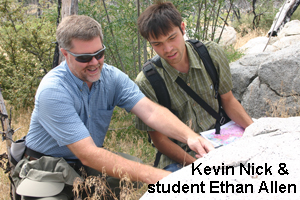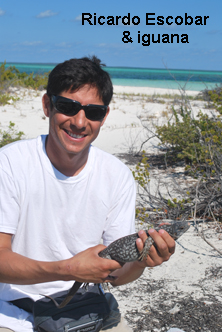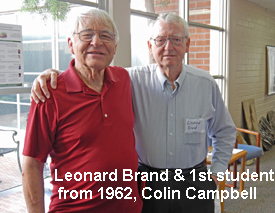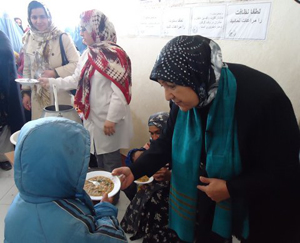
December 2013
Loma Linda is a myriad of crossing sidewalks leading to various destinations across our campus. Follow one of those paths and you end up at Griggs Hall, one of our anchor buildings that has housed many programs throughout the years. One of the departments in Griggs is also one of our best-kept secrets at Loma Linda—the department of earth and biological sciences, or what we simply call EBS. It is unique as the only department on campus whose scope includes the role of humans as part of an ecosystem about which we all need to be concerned.
So EBS has taken on that goal, that commitment, to help this campus understand and focus on natural history and environmental challenges. They have created a Center for Biodiversity and Conservation Studies that shows what an incredible world our God has created and how we can help preserve it and all who live here. Their faculty includes those with expertise in everything from geology to sea turtles, rattlesnakes to dinosaurs.

So why is Loma Linda hosting this department and faculty? It is a long story, one that has migrated through various locations and administrations. The fundamental reason for EBS is to prepare quality science faculty for our sister Adventist institutions. In a world where evolution is a dominant belief among scientists, it is hard to study and successfully compete in many institutions when one holds a biblical view of creation. So this department, originally just called the department of biology, was designed to prepare master’s and doctoral-level scientists with a solid background in our biblically based view of creation and a firm understanding of the strengths and weaknesses of modern evolutionary theories.
But studying the philosophy and science of creation solely does not give students the breadth of knowledge necessary to effectively teach in most undergraduate biology departments. So our EBS department has developed a broader base to include geology and biological research and courses supported by six well-published scientists from diverse backgrounds. And in addition to their own department’s courses, students in EBS can study with other basic scientists across the university. Let me tell you about each one of the unique faculty members in EBS.
Leonard Brand has been chair of this department on two occasions, for more than 32 years. He has been a champion of creation issues and has published a variety of books and articles on this topic. His areas of expertise are taphonomy (the study of decaying organisms over time and how they become fossilized) and ichnology (the study of tracks and traces of life in the past). A sought-after lecturer, Leonard has just stepped down from his chair position, but he will remain an active member of the department.
Paul Buchheim has also been here for many years and has actively published in his areas of expertise. These include limnogeology (the study of lake bottom sediments to reconstruct past environments and conditions) and sedimentology, which I can at least intuitively understand—the description, classification, and origin of sedimentary rock.

Kevin Nick, another of our professors, specializes in paleomagnetism, the study of fossil magnetism in rocks used to determine the past configurations of continents. Kevin is also an expert in sedimentology. You can see a trend here—a collection of solid scientists with a common commitment to study and understand the forces that have formed and impacted this earth.
The other three faculty members add even further dimensions to EBS. Bill Hayes is known as our snake guy, with expertise in herpetology and behavioral ecology. He maintains a fascinating collection of reptiles, which he shares regularly with groups in the community to educate and inform about these natural wonders. His research includes the study of snake toxins, which has complemented the clinical needs of our department of emergency medicine, as we do live in rattlesnake country.
Steve Dunbar’s expertise is in marine biology and conservation. He is the turtle guy, with a fascinating project to protect sea turtles in Honduras, where their eggs have been hunted enough to jeopardize their existence. Steve is developing alternative employment options for the local villagers there so they can support themselves without depending on harvesting turtle eggs—helping both the community and the turtles!
Finally, Ricardo Escobar is our newest faculty, with expertise in herpetology and environmental sciences. He is helping develop the newest thrust of the department on conservation studies and biodiversity. As a Christian community, we need to be more proactive in valuing and protecting our environment amid all the threats to it in this country and in ecosystems around the world. That is a message for all of us, regardless of our discipline or where we live.

To more effectively accomplish the objective of EBS, we are now moving the entire department into the School of Medicine alongside the school’s other basic science programs. In this way, it can relate to all of our basic science graduate students, whether they are studying microbiology, pharmacology, biochemistry, anatomy, or any of the other disciplines. Now many of these students can take courses from EBS during their time at Loma Linda to help them prepare for their teaching careers.
The EBS department itself offers degrees in biology, geology, earth science, environmental sciences, and natural sciences. This includes undergraduate degrees in environmental sciences and geology; master’s degrees in biology, geology, and natural sciences; and a PhD in either biology or earth sciences. Because of the commitment to prepare faculty for institutions around the world, the department has a very diverse student body from many cultures and with widely divergent interests. Graduates are now serving in colleges and universities in many countries. One of the strengths of the department has been its ability to develop scholarship funds for these students as well as research support for faculty projects.
In addition to EBS, there is another organization at Loma Linda called the Geoscience Research Institute. This is technically not part of Loma Linda University, though it sits on our campus. Headed by Jim Gibson, it has a faculty of five that conducts seminars around the world on topics related to biblical creation. Funded by the Adventist church directly, GRI collaborates with EBS on research projects, but doesn’t offer academic programs or degrees.
So the next time you think of Loma Linda, remember that we are a family of diverse interests, with great variation in our faculty and students. In our efforts to serve the world through improving health, we also look back at man’s history on this earth as well as educate about protecting the wonderful environment our God has created.
In closing, let me wish each of you a relaxing and enjoyable holiday season with family and friends. Let us all remember the meaning of Christmas and the hope it has provided each of us.
Cordially yours,
Richard Hart
PS: I talked in last month’s newsletter about one of our extraordinary graduates, Sakena Yacoobi, founder of the Afghan Institute of Learning. Sakena has just won the 2013 Opus Prize, a faith-based humanitarian award of $1 million to help the recipient fight against persistent and pressing social issues. Learn more about her humanitarian work to help women and children in Afghanistan by clicking on her picture below to watch a video.




